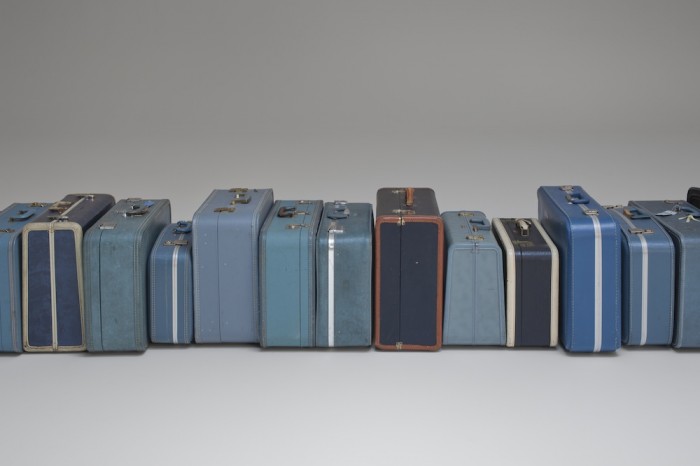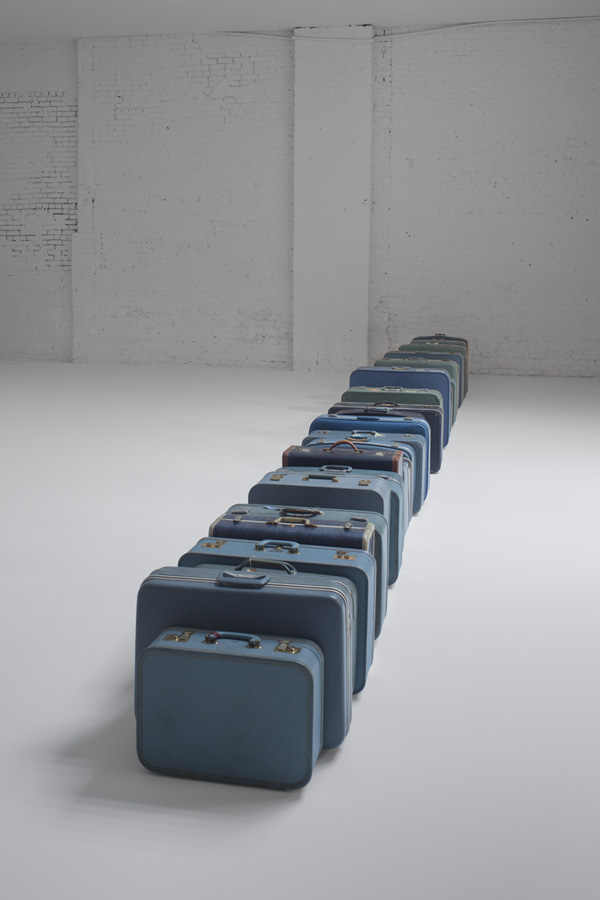Katherine Rosenheim

Zoe Leonard, 1961, 2002 – ongoing, Blue suitcases, Dimensions variable. Courtesy of the artist and Galerie Gisela Capitain, Cologne, Germany. Photo by Bill Jacobson
The exhibition Blues for Smoke curated by Bennett Simpson opened October 21st at the Museum of Contemporary Art, Los Angeles in The Geffen Contemporary. This exhibition is housed in the 24,000 sf exhibition space of the Geffen Contemporary and includes the works of 81 artists. In the main entry of The Geffen Contemporary Zoe Leonard’s “startling quiet”[1] 1961, 2002-Ongoing Suitcases[2] can be found in the midst of musical performances and video installations. Simpson organized the exhibition Blues for Smoke around a number of thematic topics, which he felt, exemplified the trans-genre influence of the blues,
articulations of domestic life; modes of abstraction and repetition; self-performance and extravagant subjectivity; ecstatic and cathartic expression; impulse towards archives and reference; and metaphors of hauntedness and memory…works by Zoe Leonard, Mark Morrisroe, Carrie Mae Weems and Lorraine O’Grady, among others, suggest intersections of sexual politics that have always marked the intimacy of the blues as simultaneously personal and social.[3]
Zoe Leonard’s 1961, 2002 –Ongoing Suitcases[4] are often viewed primarily through the lens of social context which emphasizes the materiality of the work. However, the placement of Zoe Leonard’s suitcases outside of the original framework of its first exhibition enables the work to discard its social connotations which then allows the work to exist as an aesthetic object. This transfers the work from the category of “personal and social” into the category of “abstraction and repetition.”[5] Using Rosalind Krauss’s theory of “objectivist opticality” and the use of grid originally purposed in The/Cloud/, allows Leonard’s Suitcases to be viewed not as a series of discarded suitcases but as aesthetic objects within a closed system of viewing.[6]
In the main entry way of The Geffen Contemporary Zoe Leonard’s suitcases are sitting directly on the concrete floor, arranged in a perpendicular line towards the exhibition wall. The suitcases can be viewed from either a horizontal or vertical viewpoint. From a horizontal viewpoint the suitcases form a barrier between the audience and other work in the exhibition. This horizontal vantage point also forces the viewer to take into consideration the arrangement of the suitcases and speculate about the reasons behind the particular arrangement of pattern. From a vertical viewpoint the suitcases form a single line that seems to stretch indefinitely to an “atmospheric”[7] oblivion. From a vertical vantage point the individual suitcases are transformed into a single abstract and repetitive object. The placement of the artwork against an exhibition wall gives the artwork a sense of authority, as well as grouping the individual objects into a compact form. The repetitive stacking of the suitcases references the grids and stacking of similar minimalist forms.[8] The suitcases alternate from small to medium to large. The colors blend between faded blues, greens, grays and browns. The make and model of each suitcase is distinct from the one before or behind it. These suitcases differ in period, size and color; the only connecting physical attribute is the typography. Many of the personal tags are still visibly attached to the suitcases. These faded suitcases suggest themes of use, travel, visits, storage and abandonment. All these meanings are deeply routed in the social connotations of a suitcase as a functional object. The suitcases’ materiality dominates a horizontal viewing of the work, however, once the viewer steps back and views the suitcases from a vertical vantage point, the individual nature and materiality of each suitcase disappears. The suitcases are then transformed into aesthetic minimalist objects composed of grids, lines and the melding of colors.[9]
Rosalind Krauss’s essay “The /Cloud/” begins as a review of Agnes Martin’s film Gabriel created in 1976. Krauss argues that Gabriel should not be segregated from Martin’s other body of work but used as a crypto-landscape in the analysis of her earlier paintings. “The/ Cloud/” quickly transforms from a review to an analysis of the theory motivating Martin’s abstract paintings. In The/Cloud/ Krauss introduces the theory of “objectivist opticality”[10] and the importance of the grid when viewing abstracted forms:
Let us say further that this attempt to grasp the logical conditions of vision was, like the dialectic of the ancient drive toward the utterly independent object, continually forced to include its opposite. For as the grid came to coincide more and more closely with its material support and to begin to actually depict the warp and weft of textiles…this supposed “logic of vision” became infected by the tactile. Two of the possible outcomes of this tantalization of what I’ve been calling an “objectivist opticality” are: 1) to materialize the grid itself, as when Ellsworth Kelly constructs the network of Colors for a Large Wall out of sixty-four separate canvases (nonetheless retaining the optical or the indefinite in the form of chance); or 2) to make the optical a function of the tactile (kinesthetic field of its viewer, that is to say, the succession of those viewing distances the observer might assume […] It is this closed system, taken as a whole, which preserves-like the moiré belt buckle-the drive toward the “objective,” which is to say, the fundamental classicism of its kunstwollen.[11]
Krauss argues that Agnes Martin’s work is bracketed by the “fabric of the grid”[12] and the “wall-like stele of the impassive, perfectly square panel.”[13] The bracketing of the work through closed forms prevents the insertion of the “abstract sublime” or the social context into the work. The harsh materiality of the grid allows the object to be viewed within a closed system and as a whole not as a multiple. Similar to Agnes Martin’s paintings, the theory of “objectivist opticality” and the grid can be used to bracket Zoe Leonard’s 1961, 2002-Ongoing Suitcases. The material nature of the suitcases forms a gridded system that, when viewed from a particular distance, eliminates the individual objects that construct the sculpture and replaces it with a formal object. Krauss’s theory is successful in that it expands the possibilities for the interpretation of Leonard’s work. Krauss elevates the reading of the suitcases from the personal and social context to an abstracted realm where it exists as a minimalistic object within a closed form or the gridded system.[14]
Zoe Leonard’s 1961, 2002-Ongoing Suitcases first appeared in an installation at the Paula Cooper Gallery in 2000 and then again in 2003. The work appeared in a series that also included Mouth Open, Teeth Showing,[15] a sculptural installation which featured a gang of miniature used dolls lined in a grid all facing the viewer. As Mark Godfrey noted in his article “Mirror Displacements: Mark Godfrey on the Art of Zoe Leonard,”[16] “The grids and lines meant that the aura of each object was not the point, and that viewers were not really caught up in imagining its previous user or the reasons it had been thrown away.”[17] Viewing the objects through the materiality of the forms, grids and lines that emerge through the closed system of the grid allows the work to reach beyond the confines of social commentary and exist as aesthetic object without a context within a minimalist system of abstraction.

Zoe Leonard, 1961, 2002 – ongoing, Blue suitcases, Dimensions variable. Courtesy of the artist and Galerie Gisela Capitain, Cologne, Germany. Photo by Bill Jacobson
[1] Laura Cottingham, “Zoe Leonard,” Journal of Contemporary Art, INC., www.jca-online/leonard.html.
[2] Zoe Leonard, 1961, 2002-Onging Suitcases, Museum of Contemporary Art, Los Angeles, CA.
[3] Museum of Contemporary Art, Blues for Smoke, last modified October 26, 2012, http://www.moca.org/museum/exhibitiondetail.php?&id=446
[4] Zoe Leonard, 1961, 2002-Ongoing Suitcases, suitcases, Museum of Contemporary Art, Los Angeles, CA.
[5] Rosalind Krauss, The Originality of the Avant-Gard and Other Modernist Myths (Cambridge: The MIT Press, 1997), 196.
[6] Rosalind Krauss, “The/ Cloud/”, in Agnes Martin, ed. Barbara Haskell (New York: Whitney Museum of American Art, 1992),164. Krauss argues that “objectivist optically” is “namely, an attempt to discover—at level of pure abstraction—objective conditions, or the logical grounds of possibility, for the purely subject phenomenon of vision itself (Krauss, Agnes Martin, 164).” (164 Rosalind Krauss).
[8] Mark Godfrey, “Mirror Displacements: Mark Godfrey on the Art of Zoe Leonard,” Artforum International 46, no 7 (2008): 300. “Different precedents-Minimalism’s grids and stacks-seem more obviously acknowledged in Leonard’s next sculptures….In installations at New York’s Paula Cooper Gallery in 2000 and 2003, Leonard appeared to deliberately invoke the work of Carl Andre, Donald Judd, and other artists associated with Cooper’s space.”
[9] Ibid., 300. “The grids and lines meant that the aura of each object was not the point, and that viewers were not really caught up in imagining its previous user or the reasons it had been thrown away.”
[10] Krauss, Agnes Martin, 164.
[15] Rosalind Krauss, Open Mouth, Teeth Showing, used dolls, 2000.
[16] Godfrey, “Mirror Displacements,” 300.
Katherine Rosenheim is a critic and curator living in Los Angeles, California.